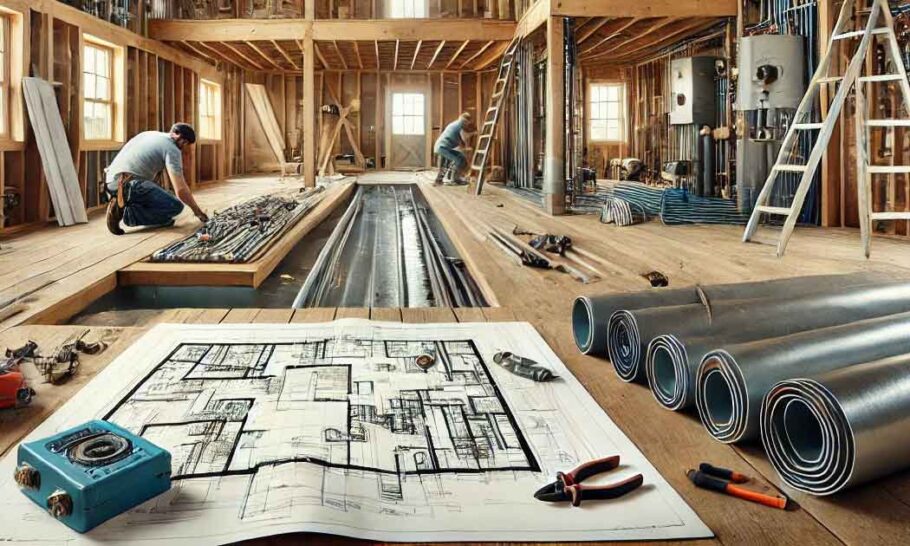Building a barndominium is an exciting venture that combines the rustic charm of a barn with the modern comforts of a home. However, to ensure your barndominium is both functional and safe, it’s essential to pay careful attention to the plumbing and electrical systems during the design and construction phases. These two critical components form the backbone of any home and require thoughtful planning to achieve efficiency, safety, and compliance with building codes. Here’s a guide to help you navigate the plumbing and electrical considerations for your barndominium project.
Planning Your Barndominium Plumbing System
Plumbing is one of the most complex systems in any building project, and a barndominium is no exception. Here are the key steps to ensure a well-planned plumbing system:
- Start with a Comprehensive Layout
Before construction begins, work with your designer or contractor to create a detailed plumbing layout. Identify where bathrooms, kitchens, laundry rooms, and other water-dependent spaces will be located. Centralizing these areas as much as possible can reduce the complexity of the plumbing system and lower costs.
- Consider Water Supply and Pressure
Determine the source of your water supply—whether it’s a municipal connection or a private well. Ensure the water pressure meets the needs of your household. If pressure is an issue, consider installing a booster pump to maintain consistent flow throughout the home.
- Plan for Drainage and Venting
Proper drainage and venting are crucial for the functionality of your plumbing system. Design the system to allow wastewater to flow freely to the sewer or septic tank. Ensure all drains are adequately vented to prevent issues like slow drainage or sewer gas buildup.
- Insulate Pipes for Temperature Extremes
Barndominiums are often built with metal exteriors, which can exacerbate temperature fluctuations. Insulate pipes to protect against freezing in winter and excessive heat in summer. This is especially important for homes in areas with extreme climates.
- Incorporate Energy-Efficient Fixtures
Opt for water-saving fixtures such as low-flow toilets, showerheads, and faucets. These not only reduce water consumption but can also lower your utility bills in the long run.
Designing Your Barndominium Electrical System
Electrical systems in barndominiums require careful planning to meet your power needs while ensuring safety and code compliance. Here are the critical factors to consider:
- Assess Your Power Needs
Begin by calculating the total electrical load your barndominium will require. Factor in lighting, appliances, HVAC systems, and any specialty equipment. Share this information with your electrician to design a system that meets your current and future needs.
- Choose the Right Electrical Panel
The electrical panel is the heart of your home’s power distribution. Ensure the panel is adequately sized to handle your load requirements. A 200-amp panel is common for modern homes, but larger panels may be necessary for barndominiums with workshops or other high-power areas.
- Plan for Outlets and Lighting
Strategically place outlets and light fixtures to maximize convenience and functionality. For example, consider installing outlets in the garage or workshop for power tools and equipment. Use a mix of ambient, task, and accent lighting to create a comfortable and versatile living space.
- Integrate Smart Home Technology
If you’re interested in smart home features, plan for them early. This could include automated lighting, thermostats, security systems, and more. Ensure your electrical system can accommodate these technologies, which often require specific wiring configurations.
- Prioritize Safety
Safety is paramount when it comes to electrical systems. Work with a licensed electrician to ensure all wiring, outlets, and fixtures comply with local codes and standards. Include safety features like Ground Fault Circuit Interrupters (GFCIs) in wet areas and surge protectors to safeguard your appliances.
Engineering for Efficiency and Safety
To optimize your barndominium’s plumbing and electrical systems, consider these best practices:
- Work with Professionals
Hiring experienced plumbers and electricians is critical for a smooth build. Professionals can help you navigate building codes, troubleshoot potential issues, and ensure the systems are installed correctly.
- Plan for Future Upgrades
Even if you don’t need all the bells and whistles now, it’s wise to design systems with future expansion in mind. For plumbing, this might mean leaving space for additional fixtures. For electrical systems, consider installing extra conduit or a larger panel to accommodate future needs.
- Conduct Thorough Inspections
Before finalizing your build, conduct comprehensive inspections of both systems. This ensures everything functions as intended and complies with local regulations. Addressing issues early can save time and money in the long run.
Conclusion
The plumbing and electrical systems in your barndominium play a vital role in creating a safe and comfortable living space. By prioritizing careful planning, working with skilled professionals, and adhering to best practices, you can ensure these systems are efficient, reliable, and ready to meet your family’s needs. With the right approach, your barndominium build will be a seamless process, leaving you to enjoy the perfect blend of rustic charm and modern convenience.

